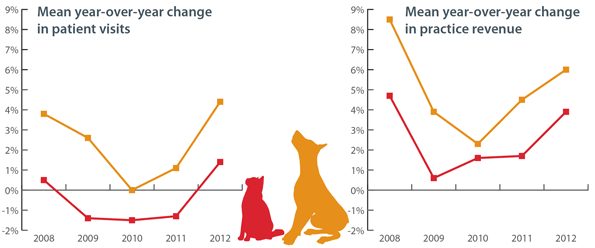Revenues rise with patient visits

Revenues rose a mean of 5.6 percent for companion animal practices between 2011 and 2012 alongside an increase in patient visits, according to the annual State of the Industry Report from the American Animal Hospital Association.
The positive report was released at AAHA’s yearly conference, March 14-17 in Phoenix. The conference also featured sessions from Partners for Healthy Pets on communicating with clients (see story) and from the Pet Nutrition Alliance on practical applications of nutrition (article).
Coming up in June, AAHA will introduce a toolkit to help practices set up mentoring programs for veterinarians who are new graduates (article).
During the March conference, Dr. Kate Knutson assumed the office of AAHA president (article). The association also gave a number of awards (article).
State of the Industry Report
Dr. Mike Cavanaugh, AAHA executive director and chief executive officer, presented the State of the Industry Report during the opening session of the conference. For the report, AAHA and Idexx Laboratories Inc. analyzed data from AAHA-accredited and nonaccredited companion animal practices across the United States.
Averaging across practices, patient visits had decreased 0.6 percent in 2010 before increasing 0.4 percent in 2011 and increasing 3.6 percent in 2012.
“About 25 percent of hospitals drove revenue growth that was greater than 10 percent in spite of the economic downturn and the other challenges we know are facing our profession,” Dr. Cavanaugh said. “These are hospitals that took growth into their own hands.”
A follow-up study by AAHA and Idexx examined differences between practices with a revenue increase of 10 percent or more and practices with a revenue decrease of 5 percent or more. Neither location nor practice size determined whether practices were growers or decliners.

“The first key to growth is focusing on strengthening your client relationships,” Dr. Cavanaugh said.
Growers tend to believe that growth results from a practice’s reputation or being well-known, word of mouth or referrals, and client communications. Decliners tend to believe that growth depends on specialized care or services and growth in the region or economy.
“The growers understand that having a full array of services is a key part of their offering, but that alone is not enough to drive growth,” Dr. Cavanaugh said. “What’s more important for growth is the ability of the veterinary team to communicate the value of the service in language that clients can understand.”
The second key to growth is driving regular patient visits for preventive care. Among the strategies to increase such visits is booking the next appointment prior to checkout. Human dentistry has achieved an 80 percent rate of forward booking for preventive care, Dr. Cavanaugh said, but the rate is only 5 percent in veterinary medicine.
Increasing the latter figure to 10 percent could generate $350 million for veterinary practices, according to analysis by AAHA and Idexx. The estimate is $450 million when combining the increase in forward booking with effective reminder systems. The estimate approaches $1 billion, or $40,000 per every practice in the country, under the assumption that regular patient visits for preventive care lead to visits for other services such as dental cleaning.
Three other keys to growth are using technology to strengthen client relationships and drive preventive care; setting goals and measuring results; and, for AAHA-accredited practices, promoting the value of AAHA accreditation standards.
“The state of our industry and our profession are at least moving (in) the right direction again,” Dr. Cavanaugh said. “These data are certainly encouraging, compared to what we’ve been seeing the last few years.”
AAHA initiatives
Starting in late 2012, AAHA named several companies as preferred business providers to offer discounts to AAHA members on products that advance a client-centric approach to practice management.
In November 2012, AAHA and Idexx announced an agreement to offer the latest version of the Idexx Cornerstone Practice Management System with the new Idexx Pet Health Network Pro client communication service. Analysis by AAHA and Idexx found that an integrated, client-centric approach—including practice marketing, regular newsletters, client education, and post-visit report cards—generates more word of mouth, stronger loyalty among pet owners, and better compliance with care recommendations.
In January 2013, AAHA and Nestle Purina PetCare announced an agreement to offer Purina’s Partners in Wellness customizable wellness programs. Partners in Wellness allows veterinarians to implement and manage wellness programs through most practice management systems. In February 2013, AAHA and Beyond Indigo Pets announced an agreement to offer website design and marketing services.
Among other initiatives, AAHA continues to provide guidelines for the treatment of cats and dogs. The association recently revised its dental guidelines; was nearly ready at press time to release new guidelines on fluid therapy, developed in collaboration with the American Association of Feline Practitioners; and expects to release new guidelines later this year on weight management.
Also during the March conference in Phoenix, AAHA donated $1,000 to the Rescue Operation for Animals of the Reservation, which supports rescue groups on reservations. The city of Phoenix matched the donation, and the company BlogPaws donated $2,500. Conference attendees donated almost $2,000.
The AAHA conference drew a total of 3,691 attendees—including 1,233 veterinarians, 272 veterinary technicians, and 104 veterinary students and veterinary technician students. The association’s membership encompasses about 3,400 AAHA-accredited practices and 1,900 nonaccredited practices.